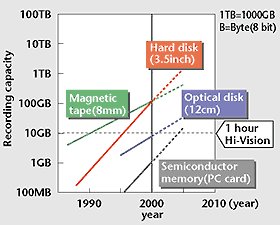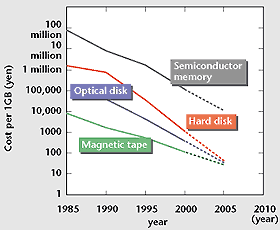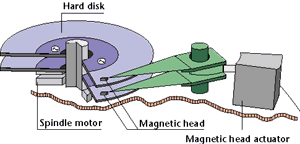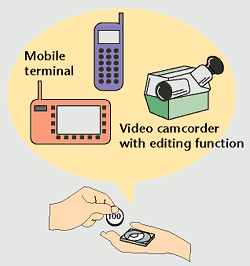Trends in the Development of
an Ultra-small Hard Disk For Mobile Terminals
If a program can be watched anytime, anywhere, viewers will be
able to utilize broadcasting in a more convenient way. In order
to realize this "anytime, anywhere" function in a mobile terminal,
an ultra-small, large capacity recording device needs to be developed.
In this article, trends in the development of high-density, large-capacity
hard disks suitable for video recording and reproduction will be
addressed. "Anytime, anywhere TV," which will be made possible by
such an advance, will also be discussed.
|
Promising hard disk for mobile terminals
Including digital satellite broadcasting, which will begin in December
2000, Integrated Services Digital Broadcasting (ISDB) will broadcast
a variety of data services in addition to TV programming. Although
these services can certainly be enjoyed through real-time direct
reception, storing the data in a home server will make any desired
programs available anytime for viewing, further enhancing the enjoyment
of ISDB services. Digital terrestrial broadcasting, which is scheduled
to begin in 2003, will enable the mobile reception of such services.
If these mobile terminals can provide any program for viewing, a
seamless broadcasting service system will be realized. The realization
of such an anytime, anywhere system will rely on an ultra-small,
large-capacity recording device for mobile terminals.
Table 1 shows the characteristics of the recording media for home
server or mobile terminal use. In order to perform the lengthy recording
and reproduction of large amounts of video data, such as of Hi-Vision
(HDTV), a recording medium will need to meet the requirements of
a fast data transfer rate and a large-capacity. Tapes, hard disks,
and optical disks can all do such large-capacity recording. Among
these, hard disks and optical disks have the advantage of prompt
recording and replaying at any specified location, without the need
for rewinding like in the case of tape media. Because of this, it
is considered that these will be important as future recording media.
A hard disk's advantageous features include an extremely short access
time and a high transfer rate, allowing seamless data replay even
if recorded video is accessed randomly. In addition to these characteristics,
its suitability for high-density recording and miniaturization make
the hard disk a promising medium for mobile terminals.
| Table 1: Characteristics of recording
media |
 |
Developing larger capacity and lowering
cost
 |
| Figure 1: Transition of recording media
recording capacity by year |
Figure 1 shows the recording capacity increase for each recording
device. The capacity of different forms of media is steadily increasing
through the adoption of new technologies. Especially notable is
the rapid capacity increase in hard disks and semiconductor memory.
When they were first developed, hard disks (IBM350, 1957) had only
2Kbit/in2 areal recording density. An improvement in
recording density has been made possible by recording and playback
using a micro field, supported by the development of high-performance
recording media, and advances in ultra-micro head processing technology.
In recent years, recording density has been increasing at a rate
of 200% a year, with the highest density presently available being
15Gbit/in2, approximately 8 million times that of the
first hard disk. This density is expected to rise to 300Gbit/in2
by around the year 2005 with the adoption of new technologies such
as perpendicular magnetic recording and the advance of miniaturized
high-performance magnetic heads.
Figure 2 shows the cost transition per 1GB recording capacity1).
The present price for a hard disk is approximately 1000 yen per
GB, with a drastic reduction in cost being observed (this price
is 1/30 that of five years ago). It is estimated that the cost will
drop to 50 yen/GB by 2005, making it comparable to optical disk
and magnetic tape.
 |
| Figure 2: Transition of recording capacity
cost per 1GB by year |
Three hours of Hi-Vision in a 1-inch disk
 |
Figure 3: Hard disk device basic structure
An ultra-small hard disk device includes all of these components
and is then miniaturized. |
The basic structure of a hard disk device (HDD) is shown in Figure
3. It consists mainly of the disk itself and a high-speed magnetic
head. Generally, it holds several disks, making it possible to change
recording capacity according to purpose.
Advancing technology in small and high-performance hard disk devices
recently made possible the development of a 1-inch disk for a home
camcorder application2). Miniaturization
requires smaller and fewer disks with the same performance. However,
miniaturizing the disk will result in a smaller recording surface
and therefore less recording capacity. In order to record large
volumes of data such as a lengthy Hi-Vision video, the pursuit of
higher density and greater recording capacity must be continued.
If we assume that we will be able to reduce a 300Gbit/in2
density hard disk (which we estimate will be available by 2005),
down to a 1-inch size, its recording capacity will be approximately
25GB. This is equivalent to 5 DVDs (120mm diameter, 4.7GB on a single
surface) and will be capable of recording about 3 hours of digital
Hi-Vision programming.
Another merit of miniaturizing hard disks is that doing so results
in a shorter head action distance and therefore shorter access time.
In addition to realizing the continuous replay of high-speed video
signals, such as Hi-Vision, the easy, random accessing of a variety
of other data will also be made possible.
Making "anytime, anywhere TV" possible
 |
| Figure 4: Ultra-small hard disk application
example |
When such an ultra-high density recording medium is realized, "anytime,
anywhere TV," on which TV programs can be temporarily stored in
a mobile terminal to provide viewers with an environment where any
program can be watched at anytime and anywhere, will be possible
(See Figure 4). When downloads of movies, music, and novels, distributed
by high-speed Internet to a small hard disk in a mobile terminal,
becomes a reality, it can be used as a personal server in which
a variety of personalized information can be stored.
Furthermore, we predict that a home camcorder with a large recording
capacity and a non-linear editing function will appear. Combining
this home camcorder and a cellular phone, a user will be able to
edit video data taken at one location and then promptly transmit
the edited data to a distant location via a cellular phone or the
Internet.
Agenda for realization
We will need to clear several hurdles to achieve this "anytime,
anywhere TV." With regard to ultra-small disk development, improvements
in low energy consumption for mobile devices are needed, as well
as quake and shock resistance.
Software to record and call up only preferred programs from mobile
terminals or home servers (metadata) will be necessary. The transmission
of metadata with TV programs is under consideration at related organizations,
such as the TV Anytime Forum3).
Suggestions have also arisen concerning copyright problems when
recording a program on a server.
A variety of other examinations are also being carried out to solve
these problems, giving us positive expectations for mobile terminal
"anytime, anywhere TV."
(Takahiko TAMAKI, Recording Technology & Mechanical Engineering)
| 1) |
A capacity that can record 6-minutes of digital Hi-Vision
data (transfer rate: 22Mb/s). |
| 2) |
1GB recording capacity hard disk device in 1-inch size (IBM
Japan). |
| 3) |
Multimedia Lab Report No.44 (6/1/2000), "TV Anytime Forum:
Standardization Trend at ABU) |
|
|

